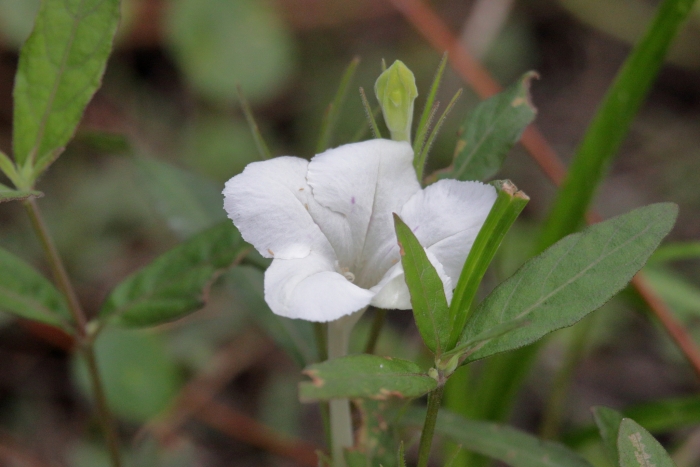Nightflowering Wild Petunia
(Ruellia noctiflora)
Nightflowering Wild Petunia (Ruellia noctiflora)
/
/

© Kim
CC BY 4.0
Image By:
© Kim
Recorded By:
Copyright:
CC BY 4.0
Copyright Notice:
Photo by: © Kim | License Type: CC BY 4.0 | License URL: http://creativecommons.org/licenses/by/4.0/ | Uploader: mcburly | Publisher: iNaturalist |

























Estimated Native Range
Summary
Ruellia noctiflora, commonly known as Nightflowering Wild Petunia, is a herbaceous perennial native to coastal plains, marsh edges, and dune systems along the Gulf Coast. It typically grows to a height of 16 inches (41 cm) with oval, pointed, and usually stalkless leaves borne in pairs on thin, hairy, purplish stems. The plant is notable for its white, trumpet-shaped, five-petalled flowers, each 3 inches (7.6 cm) long and 4 inches (10 cm) across. These flowers open at night and fall by mid-morning, displaying a unique adaptation to nocturnal pollinators such as hawk moths, whose long proboscises can reach the nectar at the base of the flower.
Nightflowering Wild Petunia thrives in moist environments and is often found in natural settings that provide high humidity and wet soils. It is a low-maintenance plant that can be used in rain gardens, borders, and as a ground cover in areas with wet conditions. Its nocturnal flowering habit makes it a unique addition to moon gardens, where it can be appreciated during evening hours. Gardeners should provide it with full sun to part shade and ensure the soil has medium drainage to mimic its natural habitat. While it requires high amounts of water, it is relatively drought-tolerant once established. One potential problem is that it can self-seed prolifically under optimal conditions, which may require management to prevent unwanted spread.CC BY-SA 4.0
Nightflowering Wild Petunia thrives in moist environments and is often found in natural settings that provide high humidity and wet soils. It is a low-maintenance plant that can be used in rain gardens, borders, and as a ground cover in areas with wet conditions. Its nocturnal flowering habit makes it a unique addition to moon gardens, where it can be appreciated during evening hours. Gardeners should provide it with full sun to part shade and ensure the soil has medium drainage to mimic its natural habitat. While it requires high amounts of water, it is relatively drought-tolerant once established. One potential problem is that it can self-seed prolifically under optimal conditions, which may require management to prevent unwanted spread.CC BY-SA 4.0
Plant Description
- Plant Type: Herb
- Height: 2-4 feet
- Width: 1-2 feet
- Growth Rate: Moderate
- Flower Color: White
- Flowering Season: Summer
- Leaf Retention: Evergreen
Growth Requirements
- Sun: Full Sun, Part Shade
- Water: High
- Drainage: Medium
Common Uses
Bee Garden, Bird Garden, Butterfly Garden, Hummingbird Garden, Low Maintenance
Natural Habitat
Coastal plains, marsh edges, and dune systems along the Gulf Coast
Other Names
Common Names:
Scientific Names: , Ruellia noctiflora, Dizygandra noctiflora, Dipteracanthus noctiflorus var. humilis, Ruellia tubiflora,
GBIF Accepted Name: Ruellia noctiflora (Nees) Gray